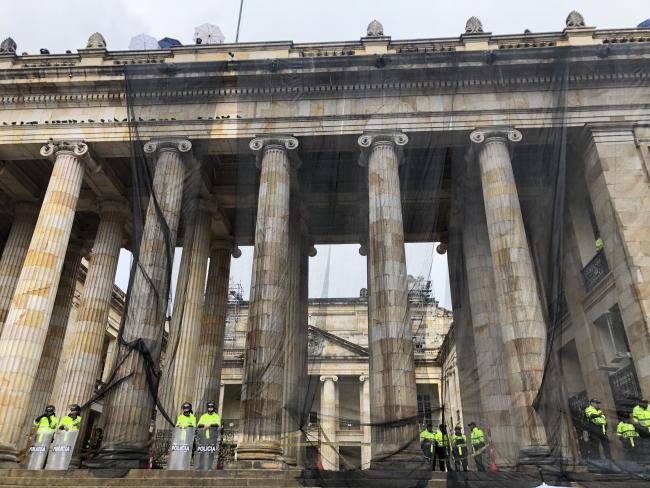by AMANDA C. WATERHOUSE

Colombian police guard the National Capitol building in Bogotá’s Plaza de Bolívar during the national strike on Thursday, November 21. PHOTO/Fabián Plazas Diaz
As Colombian demonstrators clamor for inclusive policies, genuine peace, and respect for human rights, the elite recycle discourses decrying “vandalism” that aim to delegitimize dissent.
When police shot tear gas into Bogotá’s Plaza de Bolívar on a recent Thursday afternoon, it sent the previously calm crowd into chaos. The plaza is large and wide, with broad stone civic buildings on each side and a number of narrow streets feeding into the square. As the tear gas canisters hit the ground and sent plumes of white smoke into the air, people ran, their eyes and noses burning. While the crowd had been peacefully protesting for most of the afternoon, the tear gas dispersed the demonstration into different directions. The pretext to fire came when some protesters—“vandals” or undercover police “infiltrators,” depending on who you ask—began to throw rocks and tear down and burn large swaths of thick netting strung up to protect the buildings from graffiti and other harm.
The scene showed how Colombian security forces consider infrastructure a pillar of order in the nation’s capital city. The plaza, designed during Spanish colonial times in the damero or “checkerboard” style of urban planning, was meant to maintain imperial order through both spatial and social means. In addition to this historical symbolism, today it is difficult to enter or exit the plaza en masse because of the way the long, narrow feeder streets split a crowd. Nevertheless, the plaza has a storied history as a site of dissent, from calls for independence in the colonial period to 20th century protests, as well as violent acts during the country’s prolonged conflict.
In the urban space of the city, it seems that protection of infrastructure often takes precedence over human rights.In the recent protest, the civic buildings themselves—a historic cathedral, the seat of the mayor of Bogotá, the Palace of Justice, and the National Capitol—were a principal reason that the national strike turned from peaceful to violent. This shows just how much property destruction is a trigger for police brutality both rhetorically and in real-time reactions in the street. In the urban space of the city, it seems that protection of infrastructure often takes precedence over human rights. Yet protesters, too, have critiques about the politics of infrastructure.
The recent protests have signaled a new dimension in Colombian popular politics. Organizers originally planned the Thursday, November 21 national strike to protest cuts to the pension system and labor reforms, and an array of unions joined the cause. Other groups soon attached a number of additional issues that have sparked popular discontent with the administration of right-wing president Iván Duque. These include the rampant and ongoing assassinations of Indigenous and other social leaders and human rights defenders, hundreds of whom have been killed since 2016, as well as inadequate implementation of the 2016 peace deal between the Colombian government and the FARC. The peace accords ended over 50 years of civil war that left an estimated 260,000 people dead and 80,000 disappeared.
